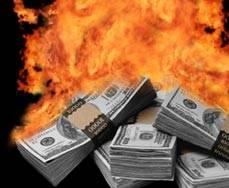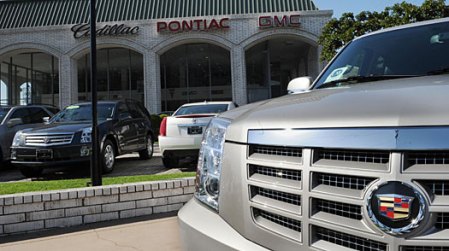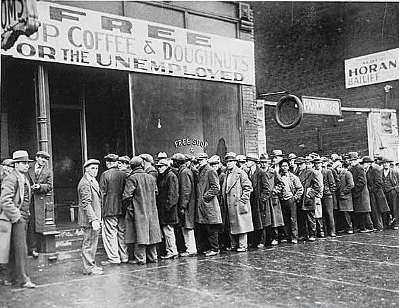April Economic Picture
Corporate Earnings
First quarter corporate earnings statements were released throughout April. Here are the ones I caught as they were announced:
Losses
3M 1st-quarter profit slips 48%
Altria Group 1Q profit drops, but beats view
AMD posts deeper loss, shares fall
AmEx 1Q profit drops 63 percent
AT&T earnings fall
Boeing posts 50 pct decline in 1Q profit
CAT reports first loss since ’92, cuts forecast
Charles Schwab 1Q earnings fall 29 percent
Chevron 1Q profit falls 64 pct
Coca-Cola 1st-quarter profit falls
ConocoPhillips says profit down 80 percent
Delta posts $794 million 1Q loss
Dow Chemical 1Q profit drops 97 percent
DuPont 1Q profit falls, cuts outlook
EBay 1st-qtr profit, sales fall on weak economy
Exxon profit sinks on slumping oil demand
Gannett 1Q profit tumbles as ad declines deepen
GE Q1 earns fall 36 pct, hurt by finance
Kodak posts wider 1Q loss, suspends dividend
MasterCard 1Q profit falls 18 pct
Mattel posts wider loss in 1st quarter
Merck sees 57 percent drop in first-quarter profit
Morgan Stanley loses $578M in 1st quarter
New York Times posts quarterly loss
Nokia profit plunges 90 percent in Q1
Pfizer profit dips 2 percent, sales fall much more
Procter & Gamble profit falls as consumers cut back
Shell 1Q profit down 62 percent
Sony Ericsson posts loss, to cut 2,000 jobs
Southwest Airlines posts 1Q loss
Time-Warner post 1Q loss
Toshiba expects bigger loss, contract job cuts
UPS 1Q profit plunges more than 55 pct
US Bancorp’s 1Q profit falls, but beats estimates
Whirlpool 1Q profit drops on weakening demand
Yahoo Posts 78% Profit Drop, Cuts Jobs
Gains
Amazon 1Q profit, revenue jump on strong sales
Bank Of America Posts $4.2 Billion Profit
Citi Posts A Profit
Goldman $1.66B 1Q earns beat Wall Street estimates
Google Solid Q1
Humana 1Q profit more than doubles
Microsoft Earnings Weak, But No Disaster
Netflix post solid Q1 sales
Pre-Easter bounce helps lift Hershey 1Q profit
Verizon 1st-qtr profit, revenue beat expectations
Wells Fargo Announces Strong Earnings
Don’t get too excited about those bank profits, though. Bank earnings are actually very weak so far. It’s all just accounting magic, mostly due to the FASB suspension of the mark-to-market rule. Wells Fargo made billions on the mark-to-market change. Goldman’s big numbers are also mostly meaningless.
But don’t take it from me. Here’s former bank regulator and current University of Missouri – Kansas City economics professor William Black:
Banking
Since William Black talked about the stress tests in the above video, let’s start with that topic.
As posted previously, the stress tests are asinine for a number of reasons, not the least being that they are designed by the same geniuses who did not see the housing bubble burst coming. Meaningless as they are, however, they did generate a lot of news in April.
Early in the month we were told that all 19 of the nation’s largest banks passed the stress test. But we couldn’t be certain of that because the Fed ordered all the banks to keep silent about their results.
By the end of April there was a leak. The whisper was that Citi and Bank of America actually failed the stress test and both were being told to raise more capital.
The next day, word was that six banks failed the stress test and now need to raise funds. And now, as of today, Bloomberg is reporting that 14 of the 19 stress tested banks are in trouble.
But there’s nothing to worry about – if you’re a bankster, that is.
The Fed says the 19 companies that hold one-half of the loans in the U.S. banking system won’t be allowed to fail — even if they fared poorly on the stress tests.
 A source at Treasury said no banks will close based on stress test results. None, even though Citi needs $10 billion more bailout dollars and Bank of America needs $70 billion more.
A source at Treasury said no banks will close based on stress test results. None, even though Citi needs $10 billion more bailout dollars and Bank of America needs $70 billion more.
After several delays, stress test results will be released Thursday, May 7.
Failed Banks
Eight banks were added to the FDIC failed bank list in April, bringing the current total for this year to 29 and surpassing the total of 25 for all of 2008. Also in 2008, only 2 banks had failed by April. This means that bank failures are up more than 1000% this year.
 With so many banks already seized by the FDIC this year, some are wondering, who’s going to bail out the FDIC?
With so many banks already seized by the FDIC this year, some are wondering, who’s going to bail out the FDIC?
Credit Card Crisis
It was only a matter of time before credit card defaults and other concerns bubbled up to the top of the news.
The Greatest Credit Card Debt Plunge Ever
Consumer credit plunged far faster than expected in February, with Americans taking on far less credit card debt. Credit card debt fell at an annual rate of $7.8 billion, or 9.7 percent. That is the sharpest drop in dollar terms ever (although the records only go back to 1968.) It’s the steepest percentage fall since 1978.
Capital One says their current credit card default rate is 8.4% and it is expected to “surge past 10%”.
It should be no surprise that millions of unemployed people are finding it difficult to make their credit card payments. That’s just common sense. And yet, Citibank said higher unemployment won’t lead to credit card losses.
TARP
What was the idea behind the TARP program again? To help banks get back to lending money? So much for that plan. The banks are now lending even less than when the TARP was first launched.
The entire TARP program is becoming very unpopular with the very banks it was supposedly designed to help. Some banks that took (or were forced to take) TARP funds want to pay it back in order to get out from under the government’s thumb. Although Treasury Secretary Geithner doesn’t want the banks to repay TARP, he may not have any legal means to refuse them.
You can’t blame the banks that are healthy enough on their own for wanting to be left alone. Citi has had to go to Treasury to ask permission to pay retention bonuses. The discussion is ongoing.
It’s all about control.
Treasury
 Treasury reported in April that it still has about $110 billion of the original $700 billion bailout fund. Expect that to be used up by the banks that need more capital based on their stress test results.
Treasury reported in April that it still has about $110 billion of the original $700 billion bailout fund. Expect that to be used up by the banks that need more capital based on their stress test results.
If the TARP bailout money is almost gone, why is Geithner refusing to let banks pay back the TARP funds they got? Weren’t the taxpayers supposed to be repaid as soon as the banks could manage it?
PPIP
The long-awaited Geithner plan for dealing with legacy securities toxic assets is doing, well, nothing really. Potential investors have shied away, with good reasons. So the deadline for investment applications was extended and the requirements for applicants were loosened.
As of April 29, 2009, Treasury is proud to announce over 100 applications to participate have been received. Wow.
Expanding TARP?
Early in April, Treasury announced it may expand TARP to bail out life insurance companies. It’s a plan scam that helps only bondholders, period.
Fraud?
Say it ain’t so! Neil Barofsky, special inspector general for the TARP, has already launched twenty investigations into possible securities fraud, tax violations, insider trading and other crimes related to the bailout funds.
In the 250-page report Barofsky submitted to Congress he also expressed serious concerns about Treasury’s latest bailout propgram, the PPIP. As Reuter’s blogger Felix Salmon observed, “not only is Barofsky worried about PPIP participants gaming the system, he’s also worried that the whole thing could easily become a front for money launderers”.
Federal Government
Budget
Congress passed the $3.5 trillion budget proposed by President Obama, “a level of spending over 10% more than the final year of the Bush administration… [with] almost all of Obama’s wish lists intact.”
President Obama has also asked Congress for a supplemental spending package of $83.4 billion for the wars in Iraq and Afghanistan.
With the largest budget in history passed and two ongoing wars to fund, we learned that the federal budget deficit grew to a record $956.8 billion while federal tax receipts are off 28%.
Revenue
The federal government ran out of cash on Sunday, April 26th, making this the earliest “debt day” ever. With no cash on hand and tax revenue shrinking at an alarming rate, federal borrowing quadrupled.
But the President wants you to know he’s serious about cutting the deficit and spending responsibly. That’s why he ordered his Cabinet to cut $100 million from their combined budgets in the next 90 days. Translated into numbers more like the ones you and I deal with on a daily basis, that’s like cutting “a latte or two out of your annual budget“.
As my dear granny would have said, “oh boy, could you spare it?”
Bailouts
The Congressional Budget Office raised its estimate of what the bailouts will cost taxpayers. As of April 4, the new estimate is $356 billion ($167 billion more than earlier estimates).
Surprise
“And the banks — hard to believe in a time when we’re facing a banking crisis that many of the banks created — are still the most powerful lobby on Capitol Hill. And they frankly own the place.” – Sen. Dick Durbin of Illinois
Retail and Commercial Real Estate
 March retail sales overall fell 1.8 percent. Excluding Wal-Mart, sales fell 5 percent. And Wal-Mart itself saw less of an increase than expected at 1.4 percent in March.
March retail sales overall fell 1.8 percent. Excluding Wal-Mart, sales fell 5 percent. And Wal-Mart itself saw less of an increase than expected at 1.4 percent in March.
“Strip malls, neighborhood centers and regional malls are losing stores at the fastest pace in at least a decade” and “ghost malls are scaring suburbs“. Commercial real estate defaults quintupled.
The second largest US mall owner, General Growth, declared bankruptcy in April.
On a somwhat related note, office vacancies rose to 12.5 percent in Q1 – the highest they’ve been in three years.
US Auto Industry
Auto sales fell to near 30-year lows in April.

Chrysler
Chrysler made the President happy when it filed for Chapter 11 bankruptcy at the end of April. This means Chrysler will get another $8 billion of taxpayer money to help them “restructure”.
But not everyone is happy with the bankruptcy terms Chrysler proposed. A group of non-TARP senior hedge fund creditors are fighting to get their clients the settlement they are legally due in a bankruptcy situation. These creditors did not make the President happy.
 GM
GM
GM will cut 1600 more jobs, force more than 1000 dealerships to close and shut down its plants for most of the summer in order to qualify for more government aid. And indeed, GM received another $2 billion from the Treasury to keep it going another month or so.
GM’s CFO announced that the company will not be making its June 1st debt payment of $1 billion. Instead, they will have “an open debt-for-equity exchange offer for bondholders on June 1”.
Bankruptcy is still a possibility for GM. Preparations are being made for this contingency, with a taxpayer cost $70 billion.
Yet another possibility for GM is a proprosal it made to Treasury that would give the UAW 39% of the company, the federal government 51% and bondholders 10%. Treasury is still mulling the idea over but my bet is that this is how it will go down. A deal that gives the government and a major labor union ownership of the company will be much to enticing for Geithner and Obama to pass up.
 Ford
Ford
Meanwhile, Ford is quietly making due without government money, capturing 16 percent of a severly limited car market in March, thanks primarily to its hybrid vehicle, Fusion.
So while Ford is still losing money as most automakers are in this economy, Ford’s stock shares were up in April.
I’m keeping my fingers crossed for Ford. If they can survive this crisis without taking any taxpayer money they will be heroes in my book.
Housing and Personal Finance
Housing
 Foreclosures were up 24% in Q1. More than 10% of recent FHA loans are delinquent. Even prime mortgage losses are exceeding expectations, at least for JP Morgan.
Foreclosures were up 24% in Q1. More than 10% of recent FHA loans are delinquent. Even prime mortgage losses are exceeding expectations, at least for JP Morgan.
Housing prices continue to decline according to the Case Shiller Home Price Release for March 2009. Take a look at Mish’s excellent analysis here.
The government’s mortgage modification program seems to be doing little or nothing which should be no surprise to anyone who looked at the details of that program.
Personal Finances
Consumer Prices Suffer First Annual Decline Since 1955, yet consumer spending still fell for the first time in three months, down 0.2%. Americans are re-learning thrift, it seems.
Bankruptcies are still rising, both business and individual. 130, 831 bankruptcy cases were filed in March 2009 – an increase of 46% over March 2008 and an 81% increase over March 2007.
And somehow, in spite of all the bad news surrounding them, consumer confidence rose in April to its highest level since last November. Huh?? My guess is that the average consumer has been watching the Dow and taking it as an indication of the economy’s general health. That and Bernanke’s “green shoots” along with Barack Obama’s “glimmers of hope”.
Having watched the stock market and other economic news much more closely over the past six months than ever before in my life, I can tell you that gauging the nation’s economic health by the stock market is stupid. Wall Street is completely disconnected from reality.
Unemployment
 Unemployment rose again in all US metro areas in March. Continued claims remain at an all-time record, 6.27 million.
Unemployment rose again in all US metro areas in March. Continued claims remain at an all-time record, 6.27 million.
The government’s official unemployment rate is now at 8.5% but in reality it is now 15.6%.
Unemployment figures combined with housing reports points to an extended period of recession still ahead of us.
Last Words
Trying to figure out what’s happening in the economy and what is ahead is a difficult proposition, perhaps even impossible. A New York Times reporter went to a number of conferences and talks and wrote about the conflicting information he heard – all based on the same data.
Nobel prize winning economist Joseph Stiglitz has blunt criticism of the Obama administration’s economic programs so far. Read the eye-opening Bloomberg interview here.
And finally, just to keep things real, have a look at “The Top 10 Signs You are Living in a Banana Republic“.
This entry was posted on May 4, 2009 at 12:27 am and is filed under Economy, Politics. You can subscribe via RSS 2.0 feed to this post's comments.
Tags: bailout, banks, Barack Obama, Bernanke, citigroup, Congress, Debt, Dow, economic crisis, Economy, failed banks, FDIC, federal government, Federal Reserve, financial crisis, government, Obama, recession, retail, stock market, TARP, taxpayers, Treasury, unemployment
You can comment below, or link to this permanent URL from your own site. Q1 GDP -6.1%
Q1 GDP -6.1%
May 4, 2009 at 10:08 am
Very interesting!
Incidentally there is an interesting website that is specifically dedicated to recession victims.It offers help and discusses all issues related to recession-www.angstcorner.com. It’s worth a visit!
May 5, 2009 at 1:24 pm
It’s a great blog with useful links, thanks, please post more.